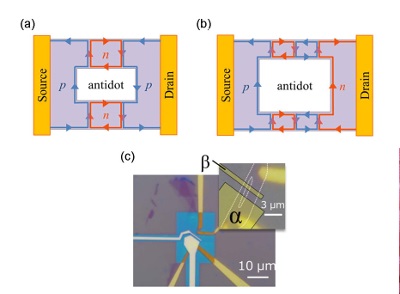A world first! Parity effect observed in graphene, a material garnering great attention

Image* Copyright : NIMS
Kensuke Kobayashi (Professor, Graduate School of Science, Osaka University) and Sadashige Matsuo (Assistant Professor, School of Engineering, The University of Tokyo), in a collaborative research effort with a research group led by Teruo Ono (Professor, Institute for Chemical Research, Kyoto University) and Kazuhito Tsukagoshi (Lead Researcher, International Center for Materials Nanoarchitectonics, National Institute for Materials Science), have theoretically projected and successfully proven through experimentation the parity effect of the quantum Hall edge transport in graphene antidot devices with pn junctions (PNJs). Graphine, or single-layered graphite, has properties of both metals and semiconductors.
This group confirmed that the parity effect in graphene antidot devices has a good analogy to optical systems. This means various quantum interference devices can be produced by using the quantum hall edge transport with pn junctions.
Abstract
We discover the parity effect of the quantum Hall edge transport in graphene, which is a new ubiquitous phenomenon in quantum Hall edge transport in massless Dirac electron systems. First, we theoretically study a graphene device with an antidot and multiple pn junctions (PNJs) and have obtained a new compact formulae to show a significant parity effect regarding the number of PNJs.
Then we have experimentally realized such graphene devices to confirm the new formulae. Our achievement is the first to establish the parity effect on bipolar quantum Hall edge transport in massless Dirac electron systems and is an important step forward to design new electron interferometer devices using graphene.
To learn more about this research, please view the full research report entitled “Parity effect of bipolar quantum Hall edge transport around graphene antidots” at this page of the Scientific Reports website (Please use the link below).
*(a) and (b): Schematic picture of the chirality of the quantum Hall edge states around a single antidot when the number of PNJs (N) is (a) even and (b) odd. The present study has established that the conductance is essentially different between the two cases, namely the parity effect. (c) Optical image of the device. The inset shows that this device has a single open window (an antidot) shown by the white curves. We tuned the top gate voltages of these two top gate electrodes, marked as a and b, in order to experimentally realize the cases with N = 0, 1, 2, and 3.
Associated links
NIMS article
Media Contact
More Information:
http://www.researchsea.comAll latest news from the category: Materials Sciences
Materials management deals with the research, development, manufacturing and processing of raw and industrial materials. Key aspects here are biological and medical issues, which play an increasingly important role in this field.
innovations-report offers in-depth articles related to the development and application of materials and the structure and properties of new materials.
Newest articles

Superradiant atoms could push the boundaries of how precisely time can be measured
Superradiant atoms can help us measure time more precisely than ever. In a new study, researchers from the University of Copenhagen present a new method for measuring the time interval,…

Ion thermoelectric conversion devices for near room temperature
The electrode sheet of the thermoelectric device consists of ionic hydrogel, which is sandwiched between the electrodes to form, and the Prussian blue on the electrode undergoes a redox reaction…

Zap Energy achieves 37-million-degree temperatures in a compact device
New publication reports record electron temperatures for a small-scale, sheared-flow-stabilized Z-pinch fusion device. In the nine decades since humans first produced fusion reactions, only a few fusion technologies have demonstrated…





















